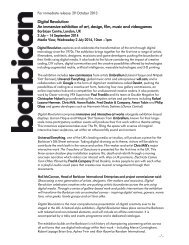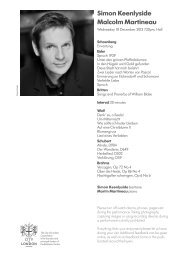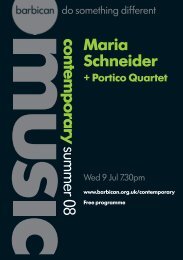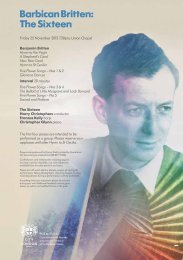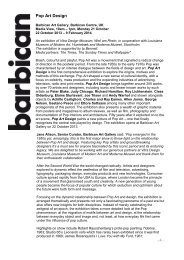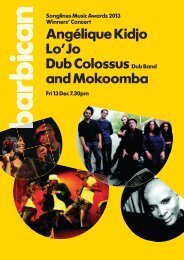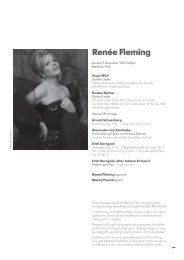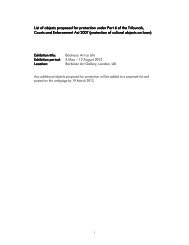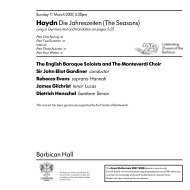Download your concert programme here - Barbican
Download your concert programme here - Barbican
Download your concert programme here - Barbican
You also want an ePaper? Increase the reach of your titles
YUMPU automatically turns print PDFs into web optimized ePapers that Google loves.
Thursday 4 February<br />
Franz Schubert (1797–1828)<br />
Symphony No. 8 in B minor, ‘Unfinished’, D759 (1822)<br />
1 Allegro moderato<br />
2 Andante con moto<br />
The years 1818 to 1822–3 were critical ones for Schubert,<br />
creatively and personally. Between February 1818, the month<br />
he completed his Sixth Symphony, and November 1822,<br />
when he embarked on the ‘Wanderer’ Fantasy, he began<br />
and abandoned nearly a dozen large-scale instrumental<br />
works, including the Quartettsatz, D703, and four<br />
symphonies. The most celebrated of these, and the world’s<br />
most famous symphonic torso, is the so-called ‘Unfinished’,<br />
begun in the autumn of 1822 and then set aside at the<br />
beginning of November.<br />
The symphony is shrouded in mystery. Schubert, whose fame<br />
as a writer of songs and partsongs was rapidly growing,<br />
composed it to no commission, with no immediate prospect<br />
of performance, and never mentioned it in his<br />
correspondence. The reasons why he abandoned the score<br />
after orchestrating two movements and sketching a scherzo<br />
and trio have been endlessly debated. Perhaps the<br />
symphony’s non-completion can be attributed to the creative<br />
crisis of 1818–22, when so many torsos testify to Schubert’s<br />
struggles to reconcile the challenge of Beethoven’s middleperiod<br />
works with his own increasingly daring, subjective<br />
vision. According to this theory, after finishing two sublime<br />
movements he was dissatisfied with the scherzo and daunted<br />
by the Beethovenian challenge of creating a finale worthy of<br />
the two completed movements. Or perhaps, as several<br />
biographers have argued, the answer lies in the syphilitic<br />
illness Schubert contracted during the winter of 1822–3 and<br />
its attendant physical and emotional traumas. What we do<br />
know is that in 1823 Schubert passed the manuscript to his<br />
friend Josef Hüttenbrenner, in gratitude for the Diploma of<br />
Honour awarded, at Hüttenbrenner’s behest, by the Styrian<br />
Music Society in Graz. The symphony remained in the<br />
possession of Josef and, subsequently, his brother Anselm,<br />
unknown to the world, until 1865, when the conductor Johann<br />
Herbeck gave the premiere in a <strong>concert</strong> of the Vienna<br />
Gesellschaft der Musikfreunde.<br />
None of Schubert’s earlier instrumental works approaches<br />
the despairing, almost confessional tone of this, the first great<br />
Romantic symphony. The tragic atmosp<strong>here</strong> of the Allegro<br />
moderato is immediately established by the brooding ‘motto’<br />
theme announced pianissimo by unison cellos and basses –<br />
a darkly haunting symphonic opening distantly presaged by<br />
Haydn’s Symphony No. 103, the ‘Drum Roll’. The mood<br />
brightens with the famous ‘second subject’, a transfigured<br />
waltz sounded on the cellos against repeated syncopations<br />
on violas and clarinets. But the idyll is quickly shattered by<br />
volcanic eruptions from the full orchestra and a passage of<br />
strenuous imitation on a phrase from the waltz theme. At the<br />
opening of the development Schubert works the motto into<br />
a protracted, yearning crescendo that generates the most<br />
apocalyptic climax in all his symphonies. The recapitulation<br />
omits the motto, which only returns, with inspired dramatic<br />
timing, at the start of the coda.<br />
After the first movement’s Stygian close, the luminous main<br />
theme of the E major Andante con moto, preceded and<br />
punctuated by a refrain for bassoons, horns and pizzicato<br />
basses, comes as a profound solace. Although the music is<br />
later threatened by tumultuous outbursts so characteristic of<br />
Schubert’s later slow movements, the dominant mood is one<br />
of mysterious serenity. In one of the composer’s most magical<br />
harmonic strokes, the coda conjures an unearthly vision of<br />
A flat major, ppp, before the music glides gently back to the<br />
home key for the tranquil close.<br />
Programme note © Richard Wigmore<br />
12




